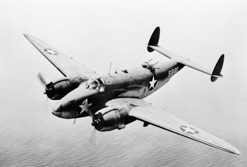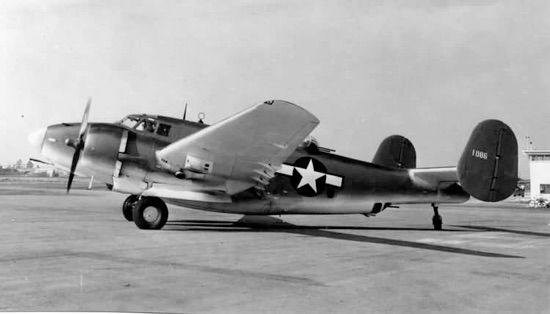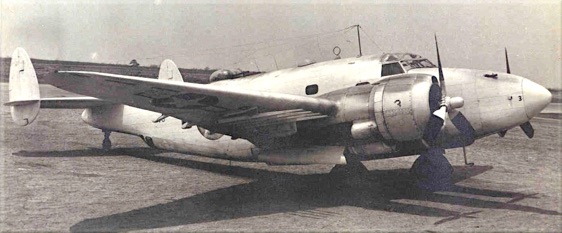PV2 Harpoon

Lockheed (Vega) PV-2(D) Harpoon
The Lockheed PV-2 Harpoon was a redesign of the PV-1 Ventura which in turn was very similar to its predecessor the Hudson. The Ventura, being larger and heavier than the Hudson, was ordered by the hundreds for the Royal Air Force, designated Ventura Mark II. The US Army Air Force placed its own order for the Ventura Mark IIA’s and put them in service as B-34 Lexington’s (later redesignated RB-34).


Hudson Ventura
In 1941 large orders were placed for armed reconnaissance versions of the Ventura designated O-56. The main difference between the O-56 and the Ventura was the engines, dropping the horsepower on the Ventura from 2,000 P&W R-2800 radials to 1,700 on Wright R-2600-13 radials on the O-56. The O-56 was redesignated the RB-34B (RB-Reconnaissance Bomber), but before even one took flight, it was renamed again the B-37.
Shortly thereafter, the US Army Air Force turned over exclusive use of the Ventura to the US Navy, so came the PV-1 Ventura. The “V” in PV-2 stood for “Vega” Aircraft Company, a division of Lockheed that built the Ventura’s. The main differences between the PV-1 and the B-34 were, the PV-1’s fuel capacity increased, to add to its range; the forward armament was reduced, and the PV-1 now included an ASD-1 search radar. The PV-1 entered service in December of 1943.
The PV-1’s had their flaws. One of which was its poor-quality take-offs when carrying full tanks of fuel. Also, the later production PV-1’s had 3 machine guns under the nose, and could carry approximately 3,100 lbs. of bombs, all of which was changed on the PV-2 Harpoon.

To try and improve the take-offs on the PV-2 the wing area increased from 551ft2 to 686 ft2, and the wingspan increased by 6 feet 6 inches to 75 feet, to increase the load-carrying capability. Unfortunately, speed statistics were projected lower than the PV-1 due to the use of the same engines but an increase in weight, but was expected to have increased range and better takeoff characteristics.
The forward guns were increased from three on the PV-1 to five on the 2’s; 2 fixed .50 inch machine guns in the upper nose decking, and 3 fixed .50 inch guns in the undernose pack. Along with the forward guns the PV-2 also carried two .50 inch guns in the dorsal turret, and two .50 inch guns in the rear ventral position.
The bomb load capacity was increased 30% on the PV-2 to 4,000 lbs., leading to a redesign of the bomb bay doors giving the PV-2 a distinctive “bulge” on the underside. Now the Harpoon could also carry two “Tiny Tim” rockets completely enclosed. She could also carry eight 5 inch HVAR rockets under the wings.

In June of 1943, the Navy ordered 500 planes under the designation PV-2, and the name Harpoon was assigned. Made for the reconnaissance role, the PV-2 included, two Pratt & Whitney R-2800-31 air-cooled radial engines rated at 2,000 horsepower for take-off, and 1,600 horsepower at 11,900 feet. Its max speed at 13,700 feet was 282 mph., at sea level 271 mph and its cruising speed was recorded at 171 mph. The Harpoon’s climbing rate was 1,630 feet per minute, and her service ceiling was 23,900 feet. The length is 52 feet 1 inch, and height 13 feet 3 inches. The Harpoon weighed in at 21,028 lbs. with 36,000 lbs. being her maximum.
First tests by the Navy on December 3, 1943, showed a dangerous amount of “wrinkling” of the wings. There was then a quick modification made involving a six foot reduction in the wingspan. Unfortunately, this didn’t cure the problem and a full redesign of the wing followed, leading to a delay of the PV-2’s service.
The PV-2 Harpoon was first taken into combat in March of 1945. The service of this aircraft was fairly brief, and was cut short by the end of the war in the Pacific. Though, the Navy continued to use the PV-2 for several years after. The Harpoon was eventually phased out of service in August of 1948.
Being declared surplus to Navy requirements, the PV-2 ended up on the commercial market sometimes ending up as private transports and modified agricultural spray planes. Several foreign air arms were supplied with surplus Harpoons including, the Japanese Maritime Self Defense Force.
The plane went through some revisions, and when all the bugs had been worked out, she was on “PV-2D”. Only 35 PV-2D aircraft were delivered before VJ Day (Victory over Japan) and after that contracts for more were cancelled. The D models included eight fixed .50 inch caliber machine guns instead of the usual five. The Harpoon in Lake Washington is believed to be one of these special “D” models.
On September 4, 1947, pilot Ensign Richard E. Donelson and co-pilot Lt. Raymond H. Soelter were preparing for take-off at NAS Seattle. The controls were checked prior to taxiing and were said to be in working order.
During take-off, Donelson stated that the tail was slow lifting so he rolled the nose down tab. The tail then rose, so Donelson rolled the tab towards the nose up position to help them become airborne. Donelson stated that he could feel pressure on the elevator controls, but supposedly the Harpoon didn’t respond to the controls at all.
According to witnesses, there was plenty of speed for the plane to make take-off, but when the PV-2 left the runway it had only about 0-3 feet of altitude, gaining only about 20 feet of altitude when the flaps were lowered. The plane, according to witnesses, skipped with landing gear down, three times before coming to a stop. The PV-2 was ditched only 1,000 yards off the end of the runway.
Donelson and Soelter were the only two aboard the aircraft when it went down. The two stated later that they knew, as they were roaring down the runway, that they were never going to get the Harpoon airborne. Knowing this, the two prepared for a water landing even before the plane left the runway. The Harpoon settled so quickly, that the cabin was filled with water to the ceiling before the two could find an escape hatch. Staying calm, the pilot and co-pilot groped around in the frigid darkness to find a hatch. Finally they did, and the two pulled themselves out and came to the surface. The plane was gone. The two men, unhurt, were picked up by a crash boat from NAS.
The PV-2 stands vertical with its nose in the mud in approximately 140 feet of water. The tail section is broken off and is positioned at the end of one of the wings.
Because the nose of this aircraft is buried in the mud, the aircraft’s "unique tail configuration and the location of the belly windows" led Bob Mester to the conclusion that this PV-2 is indeed a “D” model. On the basis of the rarity of the "D" model, Washington’s Office of Historic Preservation has deemed the aircraft eligible for listing on the National Register of Historic Places and the State Register of Historic places.




-
-Home
Below videos from Ben Griner and Puget Sound Divers
